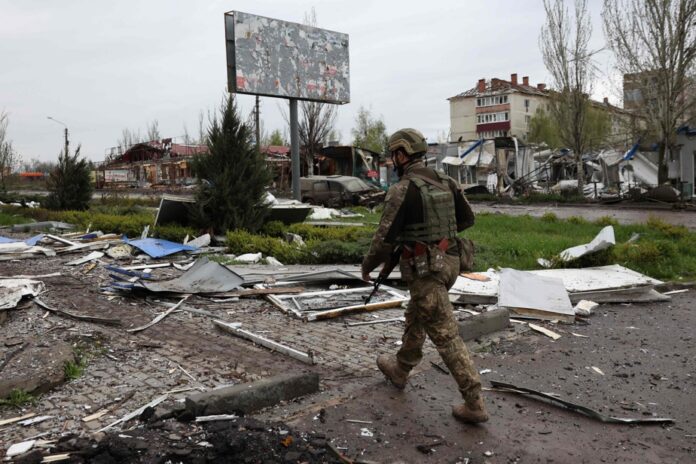(Bakhmout) Under the shells, the walls of the basement shake as a soldier, bleeding and pale-faced, is evacuated in an ambulance located outside. In Bakhmout, the epicenter of the fighting, Ukrainian forces are trying to resist the Russian advance.
Around the injured, soldiers and nurses give him first aid, before quickly taking shelter, while the Russian strikes are raining down.
“Why am I so cold, doctor?” I feel myself leaving,” said the soldier lying on a mud-stained mattress.
An AFP team was able to enter Bakhmout on Sunday, a rare opportunity for the media to see the extent of the damage in this city of some 70,000 inhabitants before the Russian invasion, which is now largely devastated.
During this trip supervised by the Ukrainian army, AFP journalists heard the muffled sound of Russian artillery fire without interruption.
Around buildings that were once inhabited and now bear the scars of war, there are only debris, shards of glass and crosses indicating the places where soldiers were hastily buried, under the fire.
Faced with the Russian army and the fighters of the paramilitary group Wagner, Ukrainian troops resist somehow in the western part of the city in what is the longest and bloodiest battle of the war.
Both sides suffered heavy casualties, the extent of which is unknown, in this battle. They are waging a slow war of attrition there before a Ukrainian counter-offensive announced for the next few months.
Despite everything, the Russian army is making progress, to the point of now controlling more than 80% of Bakhmout.
“They keep attacking us, day and night. Except when they are beaten and they are busy evacuating their dead and wounded,” the deputy commander of a Ukrainian unit, under the nom de guerre of “Philosopher,” told AFP.
“Little by little they are eating away at areas” of the city, he said from an underground command post in Bakhmout.
The struggle not to lose Bakhmut entirely comes at a significant cost to Kyiv: every day soldiers are killed or injured.
“We are tired, the troops are exhausted”, underlines the “Philosopher”, who explains how his men of the 93rd brigade sometimes find themselves within three meters of the enemy, under the fire of a constant barrage of shells .
“Each more day that we resist here gives more opportunities for other units to prepare for a counter-offensive”, he wants to believe.
Drone footage shot by Ukrainian army reconnaissance teams and seen by AFP shows a wasteland of destruction and smoke emanating from several destroyed buildings.
“They destroy everything, with thoroughness. While we shoot at previously defined targets, with more precision and adjustments with the help of drones, “says the commander.
For him, the “vulnerability” of the Ukrainians in this 10-month battle comes from the lack of ammunition.
The defense of the city seems to hang by a thread, in reality, a road. The T 0504 highway, which connects Bakhmout to the territories controlled by the Ukrainian army and supplies the units remaining in its western part.
Known as “The Road of Life” for this connection it maintains, it is also a symbol of the violence of the fighting, with its charred vehicles lying all along.
As a reminder that in Bakhmout, the line between life and death is sometimes very fine.
“From the sky, the only thing you can see are craters”, described to AFP a drone pilot with the nom de guerre “Chuck”
Along the way, charred trees line the 25-kilometre road from the nearest major Ukrainian-held settlement. Civilian cars and military vehicles spin on the muddy track, in one direction to supply and reinforce the troops in Bakhmout, in the other to get the wounded out.
“You can call it ‘The road of life’ or ‘The road of death’,” breathes Amina, a 22-year-old fighter who has been in the Ukrainian army for several months.
President Volodymyr Zelensky warned last month that the fall of Bakhmut would give the Russian army “a clear path” to advance further into the Donbass, with the cities of Sloviansk and Kramatorsk in sight.
In waterlogged fields near Bakhmout, Commander Andriï, 26, wields the cannon. His job: avoid a Russian assault from the road.
“If you cut (the road), everyone in Bakhmout is dead. No supplies. No ammunition. No food. Nothing. (Bakhmut) will be completely cut off,” he told AFP, next to his men piling up shells that had just been delivered.
“We can help the guys stay in control of the road. They can keep the city,” he said.
However, the Russians, who relentlessly pound the area, are not far away.
From a vehicle speeding down the road, Alexander, a 41-year-old Ukrainian soldier, points to one of their positions, just 900 meters away. Or the distance that his Kalashnikov can reach.
“We are fortifying our positions and the Russians are coming in throwing everything they can, everything they have. Everything is bombarded with rockets, mortars and tanks. There is nowhere to hide,” said Andriï, a 38-year-old soldier.
Several Ukrainian soldiers from the Aidar assault battalion say they lack the artillery support and ammunition to match or surpass the Russian forces.
“We lack many things. We don’t have enough guns, damn it,” Andriï says.
“If Russia captures Bakhmut, it will be a Pyrrhic victory,” says Mykola Bieliekov, a researcher at the National Institute for Strategic Studies in Kyiv.
“Wars are won by rapid offensive operations. This is not what the Russian forces did around Bakhmout,” he points out.
Bakhmout is hardly a city anymore, but above all a field of ruins.
“There are no buildings left. Everything, everything, everything is completely destroyed. Anyway, everything will have to be demolished, ”notes Andriï.


















